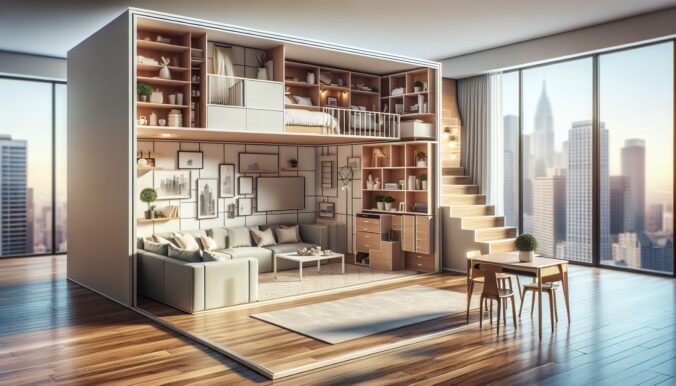In today’s fast-paced world, many of us find ourselves living in smaller spaces than we would like. Whether you’re renting a cozy studio apartment or downsizing to a smaller home, making the most of your limited space is essential. But fear not! With a few simple tricks and strategic interior design choices, you can transform even the tiniest of rooms into a functional and stylish oasis.
Embrace Minimalism
One of the key principles of maximizing a small space is to embrace minimalism. The less clutter you have, the more spacious your room will feel. Start by decluttering and getting rid of items you no longer need or use. Invest in clever storage solutions such as wall-mounted shelves, under-bed storage bins, and multi-functional furniture pieces like ottomans with hidden storage compartments. Not only will this help you stay organized, but it will also create a sense of openness and airiness in your space.
Opt for Light Colors
When it comes to small spaces, light and neutral colors are your best friends. Light colors such as whites, creams, and pastels reflect natural light and make a room feel brighter and more open. Painting your walls in a soft shade of white can instantly make a room appear larger. If you’re a fan of color, you can always add pops of your favorite hues through decorative accents like throw pillows, rugs, and artwork. Just remember to keep the overall color scheme light and cohesive to maintain a sense of continuity.
Let There Be Light
Proper lighting can make a world of difference in a small space. Maximize natural light by keeping window treatments sheer or minimal to allow sunlight to flood into the room. If your space lacks natural light, consider adding a mix of overhead lighting, task lighting, and ambient lighting to brighten up the space. Wall sconces and floor lamps are great options for adding extra light without taking up precious floor space. Don’t forget to incorporate mirrors into your decor—they can amplify light and create the illusion of a larger room.
Create Zones
In a small space, it’s essential to create distinct zones for different activities to maximize functionality. Whether you’re working with a studio apartment or a small bedroom, dividing the space into separate areas can make it feel more organized and purposeful. Use area rugs, room dividers, or furniture placement to delineate different zones like a sleeping area, a workspace, and a relaxation corner. This way, each area serves a specific function without encroaching on the others, making your space feel larger and more efficient.
Scale Down Furniture
When furnishing a small space, it’s crucial to choose furniture that is appropriately scaled to fit the room. Oversized furniture can overwhelm a small space and make it feel cramped, so opt for sleek and streamlined pieces instead. Consider furniture with legs, like a sofa or a coffee table with visible legs, to create the illusion of more floor space. Multipurpose furniture, such as a fold-out dining table or a sleeper sofa, can also be a smart choice for maximizing functionality without sacrificing style.
Think Vertically
When floor space is limited, think vertically! Utilizing your walls for storage and decor is a great way to free up valuable floor space and draw the eye upward, making the room feel taller. Install floating shelves or wall-mounted cabinets to store books, plants, and decorative accents. Consider hanging a gallery wall or a statement piece of artwork to add visual interest and personality to your space. Just be sure to use a sturdy anchor to prevent any mishaps!
Bring the Outdoors In
Bringing elements of nature into your small space can have a transformative effect on the overall ambiance. Houseplants not only add a touch of greenery and freshness to your decor but also help purify the air and boost your mood. Choose low-maintenance plants like succulents, snake plants, or pothos that thrive indoors with minimal care. Hanging plants or wall-mounted planters are excellent space-saving options for adding a touch of nature without taking up floor space. Just make sure to choose plants that suit your space’s lighting conditions.
Personalize with Textures and Patterns
Just because you’re working with a small space doesn’t mean you have to sacrifice style and personality. Incorporating textures and patterns into your decor can add depth and visual interest to your room. Consider layering different textures like cozy throws, plush rugs, and velvet cushions to create a warm and inviting atmosphere. Experiment with mixing patterns, such as stripes, florals, and geometric prints, to add a playful touch to your space. Just remember to keep the scale of the patterns in proportion to the size of your room to avoid overwhelming the space.
Conclusion
Maximizing a small space doesn’t have to be daunting—it’s all about making smart choices and thinking outside the box. By embracing minimalism, using light colors, optimizing lighting, creating zones, scaling down furniture, thinking vertically, bringing the outdoors in, and personalizing with textures and patterns, you can make your small space feel spacious, functional, and stylish. With a little creativity and some strategic interior design strategies, you can transform your cozy nook into a chic sanctuary that reflects your personality and lifestyle. So go ahead—embrace the challenge and let your creativity shine in your small space!
